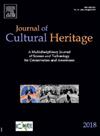基于高光谱成像数据的中国古代绢画霉变光谱指数研究
IF 3.3
2区 综合性期刊
0 ARCHAEOLOGY
引用次数: 0
摘要
书画具有重要的历史价值,在人类文化遗产的传承中起着至关重要的作用。然而,霉菌的存在极大地影响了书画的保存,从而影响了它们的文化价值和遗产。传统的霉菌检测方法依赖于人工目测和/或化学分析,受效率低、主观性强、对无损性的要求和准确性低等限制。在此,我们利用高光谱成像技术和中国古代绢画的霉变特征,开发了一种新的霉变光谱指数(MSIndex)来克服这些局限性。该方法为快速、准确、无损地提取和鉴定中国古代绢画中的霉菌提供了依据。首先对中国古代绢画的霉变光谱进行分析,并基于高光谱数据对霉变光谱特征进行优化。然后,利用这一分析,我们构建了MSIndex来检测霉菌。我们在清朝(1796-1805)沈庆兰铁洛高光谱数据集上对所提出的霉菌检测方法进行了测试,然后以1756年的Pañcika罗汉像高光谱数据集作为独立验证集,对所提出的霉菌检测方法的推广能力进行了评价。结果表明,所建立的MSIndex检测霉菌的总体准确率为94.17%,具有较好的鲁棒性和有效性。MSIndex还能够在复杂的环境中检测出霉变区域,例如涉及其他色素或疾病的环境。这种方法可以帮助专业人员制定准确的中国古代丝绸绘画修复计划,支持文化遗产的保护。本文章由计算机程序翻译,如有差异,请以英文原文为准。
A mildew spectral index of ancient Chinese silk paintings based on hyperspectral imaging data
Painting and calligraphy possess significant historical value and play a crucial role in the transmission of human cultural heritage. However, the presence of mildew greatly impacts the preservation of painting and calligraphy, thereby affecting their cultural value and legacy. Traditional mildew detection methods rely on manual visual inspection and/or chemical analysis, which are limited by inefficiency, subjectivity, the need for nondestructiveness, and low accuracy. Here, we overcome these limitations by developing a new mildew spectral index (MSIndex) using hyperspectral imaging technology and the mildew characteristics of ancient Chinese silk paintings. This approach provides support for the rapid, accurate, and nondestructive extraction and identification of mildew in ancient Chinese silk paintings. We first analyzed the mildew spectra on ancient Chinese silk paintings and optimized the spectral characteristics of mildew based on the hyperspectral data. Then, using this analysis, we constructed the MSIndex to detect mildew. We tested the proposed mildew detection method on the hyperspectral dataset of Shen Qinglan Tieluo on Qing Dynasty (1796–1805), followed by the evaluation of its generalization ability using the hyperspectral dataset of the Portrait of Pañcika Arhat (dated 1756) as an independent validation set. The results suggested that the proposed MSIndex was robust and effective with an overall accuracy of 94.17 % in mildew detection. The MSIndex was also capable of detecting mildew regions even in complex environments, such as those involving other pigments or diseases. This method can help professionals make accurate restoration plans for ancient Chinese silk paintings and support the preservation of cultural heritage.
求助全文
通过发布文献求助,成功后即可免费获取论文全文。
去求助
来源期刊

Journal of Cultural Heritage
综合性期刊-材料科学:综合
CiteScore
6.80
自引率
9.70%
发文量
166
审稿时长
52 days
期刊介绍:
The Journal of Cultural Heritage publishes original papers which comprise previously unpublished data and present innovative methods concerning all aspects of science and technology of cultural heritage as well as interpretation and theoretical issues related to preservation.
 求助内容:
求助内容: 应助结果提醒方式:
应助结果提醒方式:


